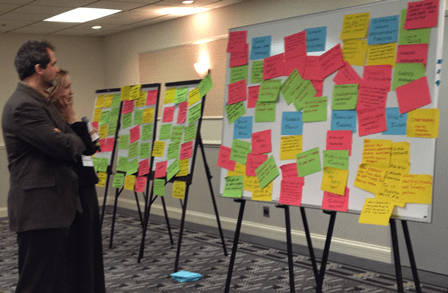FSG, the Strive Network, Tamarack, and the Aspen Forum for Community Solutions recently hosted a three-day workshop for leaders from backbone organizations of mature collective impact initiatives. This blog is part of a series sharing learning and reflection from the workshop.
During the recent workshop for backbone leaders in Cincinnati, one of the questions that arose time and again was: How do backbone organizations mobilize the funding and resources required to support and sustain the work of the collective impact initiative over time?
In addition to articulating the value-add of the backbone organization, as touched on by my colleague Sheera Bornstein recently, leaders shared additional fantastic insights on this topic:
Make the case for leverage: If someone told you that your $200,000 investment could influence over $7 million in funding, wouldn’t that sound compelling? John Kania from FSG suggested that backbone leaders, and others engaged in collective impact work, need to highlight that investments in the backbone are incredibly leveraged. Investing in the staff of a backbone entity can dramatically improve the effectiveness and alignment of all of the organizations, agencies, and systems involved in the collective impact initiative. Not a bad ROI!
Emphasize systems building: Greg Landsman, Executive Director of the Strive Partnership, stressed the importance of framing the work of the backbone as “building a better system.” Continuing to fund organizations doing work with the same system that is currently not achieving desired results does not hold a high promise for change! So, in describing the work of the backbone, Greg doesn’t focus on building infrastructure, but rather emphasizes one of the roles the backbone organization plays in building a better system: improving a community’s civic analytics. This encompasses the backbone’s critical work of creating data systems that can inform decision making for the collaborative, and using that data to drive the work of the collaborative. With improved civic analytics, the backbone works to “build a better system.”
Engage funders in creating the solution: “I would never go into collective impact process without funders at the table,” emphasized Paul Born, President of the Tamarack Institute. One of the keys to raising funds to support the backbone organization’s work is the engage funders right at the start, and as participants in creating solution. Paul also emphasized the importance of keeping funders at the table in collective impact work, where the work and solutions are bound to emerge over time. “In emergence, ‘anything’ can happen, but we can’t communicate ‘anything’ properly in a report.” Having funders along for the journey can ensure sustained support as the initiative evolved. And, for additional thoughts on roles funders can play, check out this webinar.
Mobilize resources, not just funding: While funding for the backbone is important, mobilizing resources to support the collective impact initiative as a whole is also critical. Strive’s Greg Landsman illustrated this with an example, “Our data showed that students receiving one-on-one tutoring showed great results. So rather than raise funding, we recruited people. We launched a workplace campaign with United Way and 35 local CEOs, and we will recruit 1,000 new tutors for our schools.” According to Kat Allen, Coalition Coordinator from Franklin County Communities that Care, this can be particularly critical in rural settings, “We have to think beyond funding to ‘resources.’ In our work, we do not have access to financial resources beyond government grants. So in order to handle that, we really need to look at other resources and in-kind participation, staff support, human resources.”
We’d love to hear from you about successful strategies you have used to mobilize resources for collective impact backbone organizations. Please share your advice in the comments below.

